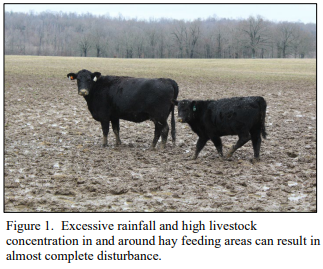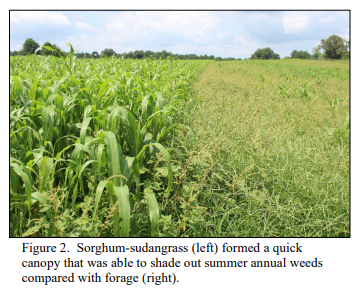 Hoof damage from livestock during the winter months can result in almost complete disturbance of desired vegetation and soil structure in and around heavy use areas. Even well-designed hay feeding pads will have significant damage at the edges where animals enter and leave. Highly disturbed areas create perfect growing conditions for summer annual weeds like spiny pigweed and cocklebur. Weed growth is stimulated by lack of competition from a healthy and vigorous sod and the high fertility from the concentrated area of dung, urine, and rotting hay. The objective of this article is to describe two approaches to revegetating these areas. Regardless of the reclamation strategy that is employed, it is important to create an environment that will allow seeds to germinate quickly and uniformly, resulting in rapid canopy closure. This will help to inhibit weed seeds from germinating. Creating this environment starts with making sure that soil fertility is in the medium to high range, soil pH is 6.0 to 6.4, and preparing a fine, but firm, seedbed. Plant cool-season grasses and legumes. The first strategy is to seed cool-season grasses or a mixture of grasses and legumes in the spring. While this is commonly done, results are usually less than spectacular in most years. Seedings are normally delayed until late spring or early summer. Consequently, seedlings do not have time before the hot summer months set in. The second reason is that summer annual weed pressure is usually very high. Figure 1. Excessive rainfall and high livestock concentration in and around hay feeding areas can result in almost complete disturbance. Summer annuals weeds like foxtail, goosegrass, spiny pigweed, cocklebur, and others actively compete with cool-season seedlings for light and water, often causing stand failures. If a spring planting of cool-season grasses and legumes is attempted, there are several things that can be done to enhance, but by no means guarantee, success. These are listed below. • Plant adapted forage species.
 Plant cool-season grasses and legumes. The first strategy is to seed cool-season grasses or a mixture of grasses and legumes in the spring. While this is commonly done, results are usually less than spectacular in most years. Seedings are normally delayed until late spring or early summer. Consequently, seedlings do not have time before the hot summer months set in. The second reason is that summer annual weed pressure is usually very high. Figure 1. Excessive rainfall and high livestock concentration in and around hay feeding areas can result in almost complete disturbance. Summer annuals weeds like foxtail, goosegrass, spiny pigweed, cocklebur, and others actively compete with cool-season seedlings for light and water, often causing stand failures. If a spring planting of cool-season grasses and legumes is attempted, there are several things that can be done to enhance, but by no means guarantee, success. These are listed below. • Plant adapted forage species.
 Plant warm-season annual grasses The second strategy involves planting a summer annual grass in late spring or early summer. This strategy has a much higher probability of success than planting cool season grasses in late spring. Summer annual grasses, especially sorghumsudangrass or sudangrass, have very rapid emergence and canopy closure. This will prevent summer annuals weeds from germinating and provide forage for grazing or harvesting during the summer months (Figure 2). Perennial coolseason grasses can then be reseeded under more ideal conditions in late summer or early fall. The following tips will help to enhance your chances of success when using warm season annual grasses.
0 Comments
Leave a Reply. |
AuthorKeep up with KBN News here. Archives
June 2024
Categories |


 RSS Feed
RSS Feed